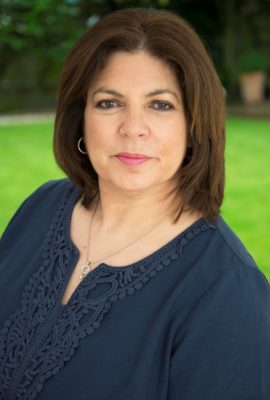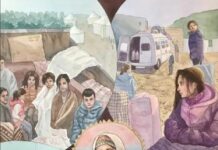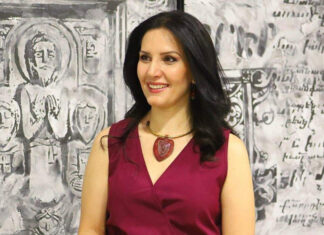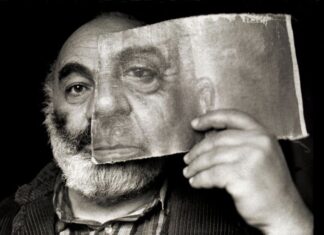YEREVAN // SOUTHAMPTON, UK — Liz Chater is an avid researcher of Armenian family history and genealogy in India and South East Asia. She is an author of books: A Prominent Armenian from Calcutta and the Grand Old Man of Hong Kong: Sir Catchick Paul Chater: A Brief Biography (2005), Armenian Graves, Inscriptions and Memorials in India – Dacca – 1722-1977 (2011), Symondsbury Dorset Cemetery Memorials and Inscriptions (2012), Eype Dorset, St. Peter’s Churchyard Memorials and Inscriptions (2012) and Marble Hall Hong Kong – A Pictorial Review and other Residences Associated with Sir Catchick Paul Chater (2012). Liz Chater runs her blog (http://chater-genealogy.blogspot.com/)with rich textual and visual information on Armenians in India. Its headline states: “Highlighting some of the lesser known, but just as important past Armenian characters in India. Those Armenians who have some sort of connection, or maybe simply buried in Calcutta and other locations in India, I re-create their lives and put them into short stories, at least as much as I am able to. The Armenians of India are unique and their stories need to be told. I hope this blog goes a little way to telling those stories.”
Liz, I am fascinated by your activities revealing the history of Armenian families and institutions of India and South East Asia. Your family name is associated with Hong Kong-based Indian Armenian businessman Sir Catchick Paul Chater, who was called the “richest and most generous man of China.” Any family connection?
Thank you for your kind words and observations. I am so passionate about Armenian family history in Asia and think it is incredibly important to not only remember the history of Armenians who once lived there, but to try and tell their stories. By doing this we can help to keep Armenian history alive and prominent, the Armenian footprints in Asia should not be allowed to fade. This is why I do what I do. There is a distant connection to Sir Paul Chater, but you know, we should also remember other equally important and prominent Armenians from India, contemporaries to Sir Paul. J. C. Galstaun of Kolkata, a generous property magnate, whose charitable and philanthropic actions towards fellow Armenians and the city of Kolkata, should not be overlooked. He was also a passionate race horse owner and trainer, and I have no doubt his path would have crossed with Sir Paul Chater. Thaddeus Mesrope Thaddeus was a jute trader, property developer and another horse race owner. There really are a number of fine, outstanding Armenians from India who were successful and gave back to their community and city with abundance. We are familiar with commercial names such as Apcar, Sarkies and Johannes. Then there are those whose commitment to education of Armenians in India were the building blocks on which the current institution stands today. D.A. David, Astwasatoor Mooradkhan and Manatsakan Varden all played crucial roles in the current education system of the Armenian College and Philanthropic Academy in Kolkata today. The only difference really between Sir Paul and all the others is that he left all his money to the Armenian Church, Kolkata. Not many of the others did so in such a generous fashion — not to the same substantial level.
How much of the history of Indian Armenians has been studied you and others and why is it crucial to research further?
I am a passionate researcher and I do so within the boundaries and limitations of the sources I have available to me. As a non-academic, that actually is quite restricted. However, there are a number of historians and academics who have and continue to research and study the history of Armenians in Asia and Persia and have produced some awe-inspiring essays and publications. For me, family history is all about knowing the basic information first, and to do that one must have that all important, birth, marriage and death information. With Armenian family history in India, the difficulty is that the registers are written in Armenian and have never been translated into English and made available. But in 2005 when I was on my first visit to Kolkata, I took the initiative, with permission, to photograph the whole of the very earliest Armenian Church baptism register which dates between 1793-1859. When I returned home to the UK, I arranged to have it translated into English and I then donated all the translations to the families in British India Society who added the details to their growing database of family history records in India. All the translations of this early Armenian register are available for free for anyone to view, and they have helped many hundreds of people around the world with their own family history. This “unlocking” of basic data is considered to be unique and is the first time any such project has been undertaken of its size. There are of course still many records in the other Church registers still only in Armenian, and it would be wonderful to be able to get these registers translated into English and made freely available for others to find their ancestors. I recently donated to the Families in British India Society some further translations related to Armenians in Yangon, again, these are available for free to view on their website database. As I do more translations I will continue to donate them to FIBIS.
I am currently heavily involved with re-creating the history of Armenian presence in Dhaka, Bangladesh. Working closely with our Warden, Armen Arslanian and our church staff, I have helped put together a little of their lost historical presence. Under the guidance of Armen, we have a really good, solid, cohesive preservation and conservation program for the church and the surrounding premises. We also have a regular food assistance program where our church staff distribute weekly over 400 meals to local people who live close to the church premises. We also arrange medical camps for locals too. Armen is quite inspirational and continues to have very strong ideas of what he wants to achieve for the future and how best to help the local communities in and around Dhaka. We continue to hope that we will eventually be able to become a UNESCO Heritage Monument and this is something we are all working towards.










